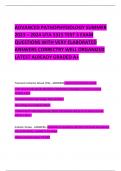ADVANCED PATHOPHYSIOLOGY SUMMER
2023 – 2024 UTA 5315 TEST 3 EXAM
QUESTIONS WITH VERY ELABORATED
ANSWERS CORRECTRY WELL ORGANIZED
LATEST ALREADY GRADED A+
Transient Ischemic Attack (TIA) - ANSWERS--Form of thrombotic stroke
-Clot temporarily blocks the flow of blood then dislodges in time to reverse
cellular injury
-Symptoms don't last longer than 24 hours
-No lasting neurological effects
-*Warning of impending stroke; Most TIA patients will go on to have a stroke
within a year.*
Embolic Stroke - ANSWERS--Occlusion is caused by clot that is formed somewhere
else in the body - usually in the heart
-Most common cause: *A-FIB*
,-Other causes: Left ventricular thrombus, left ventricular aneurysm, recent MI,
rheumatic valvular disease, mechanical prosthetic valve, patent foramen,
endocarditis, carotid artery disease
Lacunar Stroke - ANSWERS-*Small* infarcts less than 1 cm that *occur
throughout* the brain
-Involves small arteries
-Associated with hypertension, DM, hyperlipidemia, smoking
Hemorrhagic Stroke - ANSWERS--Intracerebral hemorrhage
-Causes: Hypertension, ruptured aneurysm, arteriovenous malformation,
hemophilia, anticoagulants
*Associate elderly on anticoagulants for A-Fib with hemorrhagic stroke!*
Circle of Willis - ANSWERS-Ring-like arterial structure located at the base of the
brain which supplies blood to the brain and surrounding structures.
*Provides for collateral brain circulation when other arteries are obstructed.*
Aortic Valve Regurgitation - ANSWERS--Valve is TOO WIDE or TOO NARROW,
blood doesn't pass through effectively, causing back flow of blood into the left
ventricle
,-Marked by EARLY DIASTOLIC MURMUR (on systole, heart contracts and pushes
blood up the aorta, but on diastole, heart relaxes and ineffective aortic valve is
not able to hold blood up in aorta, so blood falls and makes a swish sound, which
is the murmur)
-Most commonly caused by AORTIC ROOT DILATION(starting point of aorta is too
wide)
-Other causes: infective endocarditis, rheumatic fever, aortitis from syphilis,
coarctation (congenital narrowing of aorta), aortic dissection (tear), ankylosing
spondylitis (inflammatory arthritis)
-Acute: increases left ventricular end-diastolic pressure (LVEDP) (increased blood
back down in the left ventricle increases pressure), decreased stroke volume (not
much blood is being pushed from left ventricle because blood's backed up and
overwhelming left ventricle), normal or decreased pulse pressure, decreased
cardiac output (aorta is not effectively pumping blood from heart)
Chronic: Body adjusts; LVEDP normalizes, systolic bp increases (compensation:
harder contraction to push blood out of aorta before it falls back down to left
ventricle), diastolic bp decreases (compensation: decreased relaxation of heart to
stop blood from seeping back out of aorta), cardiac output is normal, pulse
pressure is increase. Blood ultimately is backed up into the left atrium and
pulmonary circulation.
Atherosclerosis Causes - ANSWERS--Begins with tissue injury
Sources of injury:
CIGARETTES (toxins)
, Hypertension (increased force of the blood hitting the blood vessel can weaken it)
Diabetes
Hyperlipidemia (lipids take place of endothelial cells lining the blood vessel,
initiating an inflammatory response)
Patho of Atherosclerosis r/t Hyperlipidemia - Inflammatory Response - ANSWERS-
1. Tissue injury to endothelial cells lining the blood vessel.
2. Endothelial cells become inflammed and unable to produce sufficient
antithrombotic and vasodilating cytokines, increasing risk for clot formation and
creating a tighter space for plaques and clots to grow.
3. Macrophages and platelets are called to the area of injury, further congesting
the growing plaque area.
4. LDL replaces endothelial cells in the lining of the blood vessel.
5. Macrophages engulf the LDL particles.
6. Macrophages eat too much LDL, causing them to burst and become foam cells
(under a microscope they look like sea foam)
7. Accumulation of foam cells causes a fatty streak. Fatting streak further triggers
inflammatory responses, repeating the whole cycle, and growing the fatty streak.
8. Smooth muscle hyperplasia from all the inflammation grows, produces
collagen, and covers the fatty streak to create a fibrous plaque.
9. The plaque may calcify, protrude into the vessel, and occlude blood flow,
resulting in ischemia or infarction.
Hyperlipidemia - ANSWERS-Leading cause of coronary artery disease




